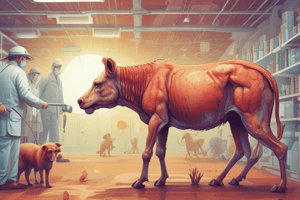Podcast
Questions and Answers
What percentage of existing human diseases are zoonotic?
What percentage of existing human diseases are zoonotic?
- 70%
- 50%
- 40%
- 60% (correct)
What percentage of emerging infectious diseases in humans have an animal origin?
What percentage of emerging infectious diseases in humans have an animal origin?
- 50%
- 90%
- 60%
- 75% (correct)
What percentage of agents with potential bioterrorist use are zoonotic pathogens?
What percentage of agents with potential bioterrorist use are zoonotic pathogens?
- 60%
- 90%
- 80% (correct)
- 70%
How many new human diseases appear every year, with how many of them being of animal origin?
How many new human diseases appear every year, with how many of them being of animal origin?
What is required to trace the origin of zoonotic viruses?
What is required to trace the origin of zoonotic viruses?
What has the development of animal coronavirus vaccines taught humans?
What has the development of animal coronavirus vaccines taught humans?
What is the main purpose of the 'One Health' approach in 'food safety'?
What is the main purpose of the 'One Health' approach in 'food safety'?
What was the source of the SARS-CoV virus that spilled over into humans?
What was the source of the SARS-CoV virus that spilled over into humans?
What was the consequence of the Rinderpest virus outbreak in Africa in the 1890s?
What was the consequence of the Rinderpest virus outbreak in Africa in the 1890s?
What is the sequence homology of Bat CoV RaTG13 with SARS-CoV-2?
What is the sequence homology of Bat CoV RaTG13 with SARS-CoV-2?
What is the role of wet markets in the spread of zoonotic viruses?
What is the role of wet markets in the spread of zoonotic viruses?
How does the 'One Health' approach aid in promoting mental health?
How does the 'One Health' approach aid in promoting mental health?
What are the three components of the 'One Health triad'?
What are the three components of the 'One Health triad'?
What is one of the risks of improper food safety?
What is one of the risks of improper food safety?
What is the outcome of removing a part of the RNA from TGEV in swine?
What is the outcome of removing a part of the RNA from TGEV in swine?
What percentage of cats with the feline coronavirus develop a transient infection with mild diarrhea?
What percentage of cats with the feline coronavirus develop a transient infection with mild diarrhea?
What is the result of the cytokine shower in FIP?
What is the result of the cytokine shower in FIP?
What is a concern with animal coronavirus vaccines?
What is a concern with animal coronavirus vaccines?
What can be learned from studying coronaviruses in animals?
What can be learned from studying coronaviruses in animals?
What is the outcome of changes in the viral genome of enigmatic coronaviruses of animals?
What is the outcome of changes in the viral genome of enigmatic coronaviruses of animals?
What is the mortality rate of TGEV in piglets?
What is the mortality rate of TGEV in piglets?
What is the result of ADE in animal coronavirus vaccines?
What is the result of ADE in animal coronavirus vaccines?
What is the significance of the Bat CoV RmYN02?
What is the significance of the Bat CoV RmYN02?
What is the result of the cytokine shower in humans infected with SARS-CoV-2?
What is the result of the cytokine shower in humans infected with SARS-CoV-2?
What is the significance of research on animal coronaviruses?
What is the significance of research on animal coronaviruses?
What is characteristic of the Pantropic Canine Coronavirus after 2006?
What is characteristic of the Pantropic Canine Coronavirus after 2006?
What is the term for the increased release of cytokines in SARS-CoV-2 infected individuals?
What is the term for the increased release of cytokines in SARS-CoV-2 infected individuals?
What is the main purpose of dexamethasone in treating SARS-CoV-2 infected individuals?
What is the main purpose of dexamethasone in treating SARS-CoV-2 infected individuals?
What is unique about coronaviruses?
What is unique about coronaviruses?
What is the name of the coronavirus that has been studied in dogs?
What is the name of the coronavirus that has been studied in dogs?
Study Notes
Zoonosis: General Info
- 60% of existing human diseases are zoonotic
- At least 75% of emerging infectious diseases in humans have an animal origin
- 80% of agents with potential bioterrorist use are zoonotic pathogens
- 5 new human diseases appear every year, with 3 of them being of animal origin
- One health approach is necessary to trace the origin of zoonotic viruses
- One health is not only about zoonoses, but also animals who are at threat from human viruses
SARS-CoV (2002-2003)
- Recombination and mutation events of the virus took place within bats
- Rapid mutations and successful spread among animals took place in wet markets, facilitated by stress, crowding, and immunosuppression
- In humans, several independent spillovers took place, with some strains of the virus undergoing further mutations, leading to an epidemic
MERS-CoV
- MERS-CoV in bats uses the same host receptor as MERS-CoV
- The virus originated in bats and spilled over into camels at least 30 years ago
- The virus is now prevalent in camels, and they have spread the virus to humans
SARS-CoV-2 (Covid-19)
- Bat CoV RaTG13 has 96% sequence homology with key differences in its genetic features
- The virus spread to pangolins and other intermediate hosts before spreading to humans in wet markets
- The spread of this virus to intermediate hosts is closely related to RBD
- Bat CoV RmYN02 has S1/S2 cleavage site insertion, 97% homology replicate gene, and 82% overall homology
- SARS-CoV-2 in humans acted similarly to FIP in cats, causing an increased release of cytokines (cytokine shower)
- The cytokine shower alone killed people, and for those who survived, it triggered a hyperimmune response, causing the release of inflammatory fluid, killing people by essentially drowning from fluid buildup in their lungs
Coronavirus: General Info
- Lessons from animal viruses aid in tackling emerging human viruses and vice versa
- CoV = coronavirus
Coronaviruses are Enigmatic due to their Behavior
- Pantropic Canine Coronavirus in dogs:
- Started as causing self-limiting diarrhea in puppies and generally mild infection
- Progressed to being a highly virulent pantropic CoV with acute systemic disease after 2006
- Has tropism for internal organs and has a high case fatality
- TGEV to PRCoV in swine:
- TGEV is an enteric virus that causes severe diarrhea and has a high mortality rate in piglets
- TGEV had a part of its RNA removed, causing the virus to transform into PRCoV
- PRCoV causes mild upper respiratory disease in pigs and induces an immunity against TGEV
- Feline Coronavirus in cats:
- Causes FIP in 1-3% of cats with the virus
- 70% of these cats will have a transient infection with mild diarrhea
- 5-10% of these cats will have a resistant infection
- FIP involves the cat's monocytes becoming infected, which triggers the release of cytokines (cytokine shower)
- The cytokine shower causes systemic inflammation
Animal Coronavirus Vaccine Issues
- Lack of complete protection
- Short duration of immunity
- Virus shedding from vaccinated animals
- Correlates of protection against CoVs
- Emergence of multiple serotypes/subtypes, including virulent recombinants between vaccine and field strains
- ADE (antibody-dependent enhancement) enhanced disease
Learning from Coronaviruses in Animals
- Animal coronaviruses allow humans to learn from host-pathogen interactions in bats and other intermediate hosts
- Animal coronaviruses allow humans to learn from molecular epidemiology, pathogenesis, and therapeutic and prophylactic strategies in animals
- Enigmatic coronaviruses of animals have changes in viral genome that alter tissue tropism and pathogenicity
- Animal coronavirus vaccines have shown humans various strategies, whether or not they are effective, and possible side effects (ADE)
- The use of animal models teaches humans about pathogenesis, immune responses, therapeutics, diagnostics, and vaccines
One Health
- Pathogens and toxins are transmitted to the environment, animals, and humans through channels like water, soil, and animal handling
- Food safety requires teamwork to identify these channels
- The one health approach of "food safety" makes our food safer
- Risks of improper food safety can lead to Norovirus and Rotavirus in humans
- Food security is a threat of transboundary viral diseases, such as Rinderpest (in South Africa)
- One health plays a role in economics
- One health aids mental health by educating people about illnesses to prevent their ignorance and stereotyping
- The one health triad includes: healthy people, healthy environment, and healthy animals
Studying That Suits You
Use AI to generate personalized quizzes and flashcards to suit your learning preferences.
Related Documents
Description
Explore the fascinating world of zoonosis, where diseases are transferred from animals to humans. Learn about the statistics, importance of one health approach, and more.





